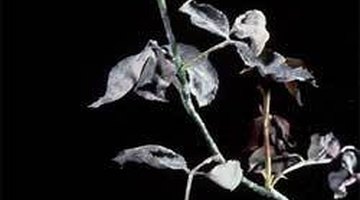How to Kill Mold & Mildew on Flowers
Mold and mildew are recognizable plant diseases. These identifiable attackers of plants and flowers presents with a white, powdery, string-like growth. It appears on flower petals, stems and leaf surfaces.

Things You Will Need
- Gloves
- Mask
- Fungicide
- Spray bottle
The mold and mildew found on the flowers rarely kills them, but it can inhibit their growth and weaken their health. Killing the mold and mildew is possible with the right products.
-
Water your plants early in the day so the moisture accumulated on the flowers can dry before sunset.
-
Space your flowering plants far enough apart to allow for good air flow.
-
Prevent a mold and mildew infestation by applying a liquid fungicide to the soil every one to two weeks during optimum weather conditions. Fungicides can be purchased at any home and garden store. Follow the manufacturer's recommended instructions.
-
Spray garden plants and flowers that have already been attacked by mold and mildew with a fungicide mixture. Add 2 tbsp. of liquid fungicide to 2 gallons of water.
-
Coat the flowers and leaves with the fungicide mixture once a week for three weeks. The fungicide kills the mold and mildew in seconds. The dead spores are washed off the flowers with the next rainfall or watering.
Tip
The spores from mold and mildew are abundant in our gardens, yet the diseases caused by the fungus thrive best in certain weather conditions. Cool night temperatures, mixed with warm day temperatures, and high humidity, are ideal for mold and mildew growth.
Warning
Wear gloves to protect your hands from chemicals and a mask to prevent inhaling the fungicide fumes. Spores released from mold and mildew cause respiratory illness and hard-to-control allergies. The spores are too small for our naked eyes to see, so inhaling them from the air is a concern.
Tips
- The spores from mold and mildew are abundant in our gardens, yet the diseases caused by the fungus thrive best in certain weather conditions. Cool night temperatures, mixed with warm day temperatures, and high humidity, are ideal for mold and mildew growth.
Warnings
- Wear gloves to protect your hands from chemicals and a mask to prevent inhaling the fungicide fumes. Spores released from mold and mildew cause respiratory illness and hard-to-control allergies. The spores are too small for our naked eyes to see, so inhaling them from the air is a concern.
Writer Bio
Lacy Enderson is an Addictions and Recovery Counselor. She is Certified with the American Association of Christian Therapists and holds a Master's Degree in Biblical Counseling. She is currently enrolled in Liberty University's Master of Divinity Degree program with Chaplaincy. Lacy is a graduate of Rhema Correspondent Bible School and has completed the first section of Berean School of the Bible. Lacy is the author of, "Addiction: A Personal Story" and "So You Want to Lose Weight But You Can't Stop Eating." Her newest novel is a teenage Christian fiction titled, "Honey Sweetheart."
Photo Credits
- http://www.greencure.net/powdery_mildew.asp
- http://www.greencure.net/powdery_mildew.asp
More Articles



